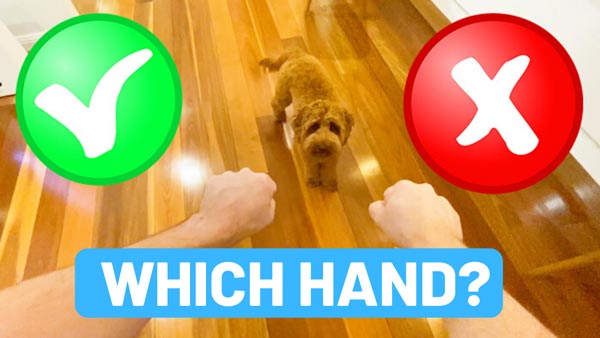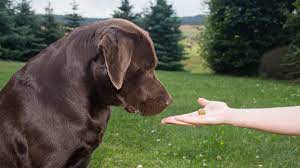Updated March 15, 2022
Mental Games

Hide and Seek
A great way to learn and practice “come”, this is a perfect game for kids and dogs alike. Hide somewhere in your house and call your dog to come to you. Start where your dog can easily see you. Be very excited, using a high-pitched voice and slapping your legs with your hands. Repeat the come command (“Come” or “Find Me”) and your dog’s name. Praise your dog at every step. When he/she does find you, provide huge praise. Treats are optional.
Name It
Pick a favorite toy. Pick a one- or two-syllable name for that toy (Moira’s stuffed Ewok is “Wok”). Wave the toy around and/or throw it. Be very dramatic, repeating the toy name over and over. (“Get your wok! Where’s your wok?”) Each time the dog touches or picks up the toy, praise lavishly. (Treats are optional) Place the toy on the floor and tell your dog “Get your …” Again praise lavishly for touching the toy.
Repeat this process for the next toy. Be sure that each toy has a specific name, such as “Tenni” for a tennis ball and “Bouncy” for a rubber ball . To test the dog’s knowledge, place the two toys side by side. Ask for a specific toy. Praise for touching or picking up that toy. If dog touches the wrong item, pick up the incorrect item, and leave the requested toy for dog to touch. This way the dog always “wins” and is encouraged to keep playing the game.
Gradually add new toys and names. See how many your dog can learn.

Find It
Great for Mental and Physical exercises. This is an excellent way to find remote controls that are misplaced, or when you simply cannot remember where you put your keys or cell phone.
It is also a great way to distract yoru dog when he/she is pestering your for attention. It is a variation on the hide-and-seek game.
First teach your dog the names of various objects (see “Name it” above). Remember, you must be very specific in naming each individual item.
Place the object in your hand or immediately in front of you. Say “Find” or “Where is …” and the object’s name. Each time the dog touches the object, provide praise. (Treats are optional). Next, place the object in your closed hand or under your hand. Repeat the “Find” or “Where is…” command. Again, each time the dog touches your hand, provide praise. Gradually hide the object in less obvious places. Start by hiding it behind your back or under your leg and gradually increase the difficulty in locating the object.
You also can teach your dog to find certain smells. Place the scent on a freshly cleaned towel or new paper towel. (For example, use a drop of milk on the towel.) Play the “Name It” game. Tell your dog “Milk! Good job” (for touching), “Now find milk” (hide the towel). Again, gradually hide the scented item in harder-to-find places. Be sure you do not use anything that your dog is likely to eat such as peanut butter. The dog will eat the towel and the smell on it, possibly causing serious intestinal issues.
You can teach your dog to signal you in different ways when he or she finds the object: Bark, sit down, pick up the object and bring it to you. If you are having the dog bring you the item, be sure that he or she is very accomplished at “soft” or “light” and does not bite down when carrying things in his/her mouth. (More about this below.) To teach your dog to sit when he/she finds the object, praise your dog for finding the object, then give the “sit” command. Barking is a little more difficult to teach. Wave your arms, make lots of noise, anything to get your dog to bark at you. This is a good way to control your dog’s barking because you reward only barking for a reason, such as signal that he/she found an item.
This is the same procedure used to train drug- and bomb-sniffing dogs used by the police and military.
Gentle/Easy

Do not attempt this if your dog has a biting issue or food aggression/protection issues. You could be badly bitten.
You can also teach your dog to be gentle by offering one piece at a time of dry kibble at mealtime. If the dog snaps or grabs at the piece, withhold the next one for several seconds. If your dog takes the kibble gently, immediately offer another. The more controlled your dog is, the more quickly additional food is offered.

Soft/Light Mouth
To teach your dog to carry an item without damaging it, teach a separate command such as “soft” (mouth) or “light” (touch). After issuing the command, praise the dog only when it takes the item or treat from your hand without biting down or breaking the treat. Specific training toys (such as retriever dummies) are specially designed for this purpose. These dummies have rubber knobs on them that are uncomfortable (but not painful) when the dog bites down. Remember to praise each time your dog takes the item in his/her mouth without biting down. If he/she bites down, issue a sharp verbal correction such as “Ahhhhhhh,” move the treat away and repeat. Remember that “Soft Mouth” and “Gentle/Easy” are not the same commands and need to be taught separately.